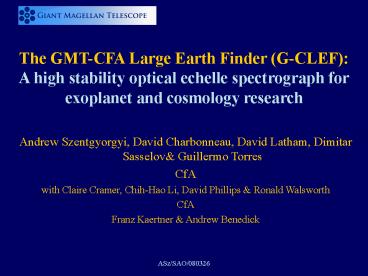Andrew Szentgyorgyi, David Charbonneau, David Latham, Dimitar Sasselov - PowerPoint PPT Presentation
1 / 31
Title: Andrew Szentgyorgyi, David Charbonneau, David Latham, Dimitar Sasselov
1
The GMT-CFA Large Earth Finder (G-CLEF) A high
stability optical echelle spectrograph for
exoplanet and cosmology research
Andrew Szentgyorgyi, David Charbonneau, David
Latham, Dimitar Sasselov Guillermo
Torres CfA with Claire Cramer, Chih-Hao Li, David
Phillips Ronald Walsworth CfA Franz Kaertner
Andrew Benedick
2
Science Missions for G-CLEF
- Find real earth mass, rocky planets in the
habitable zone of a star exoearths - Search for variation of fundamental constants on
cosmological time scales - Asteroseismology
- Directly measure the acceleration of the Universe
(but this may be very hard )
3
Exoplant Context
- Useful exoplanets are transit planets where the
mass and radius are known. - Today ( 1year) Kepler Corot massive
space-based photometric surveys will find 10s of
exoearth candidates. - PRV required to measure mass PRV to identify
real exoearths challenging. - Important for TPFs and analogues
4
Transit Planets Are Evidently Numerous
31 Known Transit Planets (last Thursday, 27
shown)
- Torres, Winn Holman arXiv0801.1841v3
5
Transmission/Occultation Spectroscopy
Methane and water on HD189733b Swain, Vasisht
Tinetti arXiv0802.1030
Weather on HD189733b Knutson et al. Nature,
447, 183
6
Gas Bags, Waterworlds and Earth Analogues
From Charbonneau Deming ExoPTF White Paper
arXiv0706.1047
7
Interior Structure of Super-Earths with Kepler
HARPS-NEF
Valencia, Sasselov, OConnell (2006)
8
Motivation for exoearth searches around FGK
dwarfs
- There is one rocky earth-sized planet in the
habitable zone of a G star (that has surface
water in liquid phase) - Habitable zones are large occupancy probability
high - Rich structure of narrow lines that presently
enable PRV to below 1 m/s - These lines are in the optical where techniques
are mature - Well matched to currently calibration available
techniques (I2 continuous ThAr)
9
Motivation for exoearth searches around M
Dwarfs(see Charbonneau Deming ExoPTF White
Paper)
- Exoearths in HZ are easier to find around M
dwarfs - Reflex signal is large for exoearths.
- M stars are relatively numerous, so small HZ is
compensated by large number of candidate. - HZ orbits are small, so transits of exoearths in
HZ are more probable. - M dwarf transits are deeper for fixed exoplanet
radius - HZ transits are more frequent in smaller HZ
orbits. - Exoearths spend more time in eclipse in M dwarf
HZ orbit.
10
An Earth mass planet orbiting
11
M5-M6 May Be the Sweet Spot
- Nutzman Charbonneau (2008)
- M5 M6 are
- Numerous
- Bright
- Often low V Sin i
12
MEarth Transit Search
- 2 telescopes now, soon to be 8
- Survey 1,976 late M dwarfs in 3 years
- If occurance of planets in HZ is 10 expected
yield is 2.6 planets to 2 Mearth
16 Telescope
Phil Nutzman Midget Graduate Student
13
Technical consideration
- FGK dwarfs?
- Requires extreme PRV 10 cm/sec precision.
- No clear understanding what intrinsic PRV limits
are. - M dwarfs?
- Requires working in the red end of optical
passband. - No good calibrators exist today.
14
Spectral Quality for Velocimetry
per Connes(1985), Bouchy et al.(2001)
Doppler Shift
Intensity Change
per pixel i
Weight
Quality
15
Quality as a Figure of Merit
From Bouchy, Pepe Queloz 2001, A A, 374, 733
16
Solar Spectrum
Intensity
Derivative
Kurucz Atlas Model, Convolved to R120,000
17
Telluric Absorption
99 Mask
18
Solar Quality, 99 Mask
19
GJ 411, M4 Dwarf
Intensity
Derivative
20
GJ 411 Quality 99
21
GJ 411 Quality 99.9
22
PRV Calibration Difficulties(The Searching Under
the Lamp Post)
- I2 cells
- Have usable bandpass in 500 600nm
- Poor efficiency
- ThAr Hollow Cathode Lamp
- Line spacing irregular, uneven brightness
- Hard to use longward of 660 nm
- Lamps have personality finite lifetime
23
Laser Comb Capabilities
- Potentially have wavelength stability (to 11015)
- Potential for wavelength calibration in
300-1100nm - Regular comb of features
- Relatively uniform brightness
24
Comb Laser Fundamentals Femtosecond Lasers
Ultraprecise Atomic Clocks
Ideal comb laser
Envelope of real comb laser output
- Real comb lasers
- Stability determined by stability of trigger
- To date, features too closely spaced feature
unresolved
25
Thinning Out the Comb
- Suppress all but every nth comb tine with an
etalon - Stabilize sidelobes with actively controlled
etalon
26
(No Transcript)
27
(No Transcript)
28
Broadening the Passband(100 nm at a time)
- 600-1000 nm
- Done ? TRES then MMT
- Doubling to 400-500 nm
- Soon ? HARPS - NEF
- Doubling to 500-600 nm
- Requires research ? G-CLEF
29
G-Clef Parameters
- Fiber feed scrambling
- Red channel first, blue channel second
- Need gravity-invariant location for spectrograph
- Probably looks a lot life HARPS/UVES
- Lessons from PFS grating or whole spectrograph
in vacuum?
30
G-Clef Needs a Fixed Gravity Vector
- Fiber length should be short (gt20-30m)
- Optical feed should not be Baroque
31
Optical Design for Fiber Feed Guide
- Feeds fibers at fixed point
- Preliminary reducer design
- Preliminary guide system design































